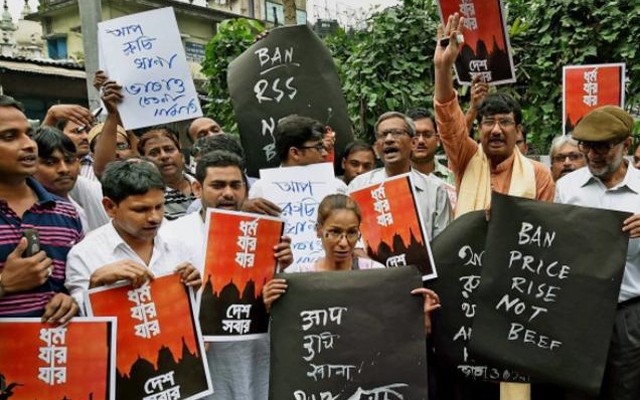India’s minorities, particularly the Muslims, are facing tough times. The matter has received great attention for the anti-beef agitation mounted by a section of Indians from the majority Hindu community, anti-intercommunal marriages – Love Jihad et cetera – and aggressive doubting of Muslim loyalty to India.
In this hostile environment, the concerns expressed by high profile Muslims like Shahrukh Khan, Amir Khan and others have made the issue very public. The fact that such super stars who are supposedly above all such discriminations and belong to the very rich and celebrated status makes the issue serious.
If the stars face such situations what about ordinary Muslims? But is it a problem of India alone or has South Asia failed to resolve its minority issue within the wider nation state framework?
South Asia has largely been built on its anti-colonial nationalist platforms, but there is not enough agreement on which nationalism fits everyone. The identities that have pushed politics in the region are several and have often run counter to each other.
Professor Anil Seal in his iconic book, “Emergence of Indian nationalism: Competition and collaboration in the later 19th century” described various identities at work in nation-building, which were often working together but also in serious conflict with each other.
Subsequently, they created separate platforms.
It would seem that the idea of a single India was as problematic as that of two or even more national identities.
One nation theory was suspect to the Muslims of India, but Jinnah’s two nation theory was suspect to the Bengali Muslims too.
So If India one gave birth to a Hindu-dominated nationalism and Two Nation theory to a Muslim-dominated Pakistan, the three Nation theory of Bengalis and later Bengali Muslims was trying its best to put its feet forward in competition.
And we saw that in the emergence of Bangladesh.
But within India the largest unrecognised “national” voice was that of the Dalits who didn’t feel one with the Congress led India.
Baba Ambedkar who became a Buddhist out of his rejection of Brahmin-led Hindusim shows the deep fissures that run there, and Muslims are not the only group discriminated against.
Politics in North and South India recognises the caste factor, and it’s not just the Dalits, but the non-Brahmins who are banding together to produce their own internal nationalism. The recent BJP defeat in Bihar is directly attributable to this equation.
So multiple identities of nation in a crude sense continue to run even after the nation states of the majority emerged.
But Bangladesh is no different in steamrolling its own majoritarian nationalism over others.
Its treatment of Hindus and Adivasis is a good example of how almost 10% of the people have been marginalized, and a significant part of this population is not just victimized, but many have been forced to leave their own land after the 1971 war brought independence, which was supposed to end such discriminations.
So India is not the only guilty one. So are Bangladesh and other South Asian countries.
This is probably because democracy has not found its space beyond electoral booths even in the most politically developed country – India.
The state has failed to develop an egalitarian national governance policy that is inclusive of all. Instead, in many cases, it has imposed the “enemy identity” on its minorities.
In India, the Muslims are secret Pakistanis; in Bangladesh, the Hindus are secret Indians; in Sri Lanka, the Tamils are Indian agents; in Nepal, the Madhesis are pro-Indian; in Bhutan the Lhotshampas and others of non-Bhot origin were considered ethnically Nepalese and expelled; and in Pakistan everyone is an enemy of each other.
Thus minorities are not full citizens, but one holding another loyalty while living in the majority’s land.
In this toxic use of identity to gain advantage, everyone has participated but those countries which have a better functioning democracy have done better than those with weak ones.
Understandably, India is doing the best but hardly at a commendable level. The lower castes due to sheer size can’t be ignored as non-Brahmins form the majority of Indians.
But power is numerical in South Asia, so Muslims of India will not have the same advantage as the Dalits.
Barring the lower castes in India who are actually the majority, the minorities will have to wait for better days in other parts of south Asia.
But there are other “nations” in waiting who are not considered nations by politicians, but are systemically discriminated against as a group.
The most visible of this group are women who despite being half of the population, are victims of male majorities.
The Adivasis all over South Asia suffer, and so do the poor and other vulnerable groups.
Thus the nations born as a state have failed to deliver equity let alone equality. It goes beyond politics.
It is about the hierarchy between the advantage-takers and the victims who join nationalist projects and fight as one, but once victory is achieved they are ignored.
Bangladesh is no exception to this arrangement.
Mere state-making is hardly enough. It’s only when we share the benefits of the state justly and fairly that we should be proud to call ourselves a nation-state, and not before.
Source: bdnews24










